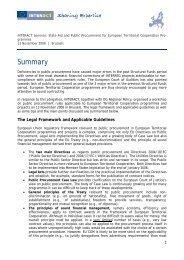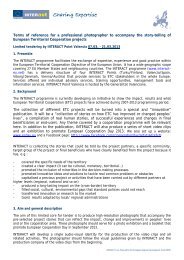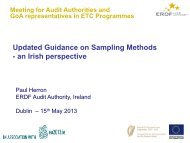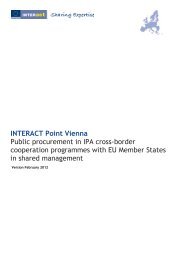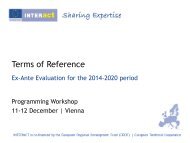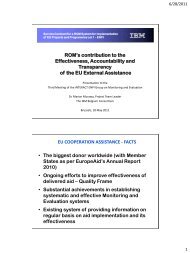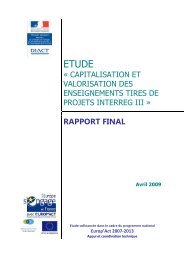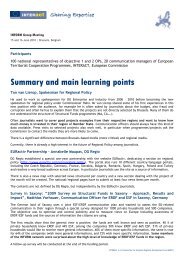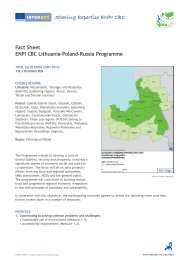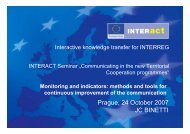Newsletter INTERACT | Issue 2011-03 | N8 | Communication
Newsletter INTERACT | Issue 2011-03 | N8 | Communication
Newsletter INTERACT | Issue 2011-03 | N8 | Communication
Create successful ePaper yourself
Turn your PDF publications into a flip-book with our unique Google optimized e-Paper software.
inter<br />
act<br />
march <strong>2011</strong><br />
communication<br />
a strategic tool for territorial<br />
cooperation<br />
<strong>INTERACT</strong> is co-financed by the European Regional Development Fund (ERDF)
contents<br />
04<br />
no news is good news,<br />
but is good news no<br />
news?<br />
Interview with Raphaël Goulet<br />
and Peter Fischer of the<br />
Information and <strong>Communication</strong><br />
Unit of DG Regio.<br />
14<br />
joint launch conferences<br />
via video stream<br />
RegioClima project<br />
experience.<br />
22<br />
yellow jersey for<br />
hungary – slovakia<br />
Travelling across borders<br />
to promote cooperation.<br />
07<br />
talking about a<br />
revolution…<br />
How social media have<br />
changed our ways of<br />
communication.<br />
16<br />
MED EMPORION<br />
project<br />
Innovative ways to<br />
approach the public.<br />
24<br />
evaluation and<br />
communication – make<br />
it more tasty!<br />
Recipes for a successful<br />
evaluation.<br />
10<br />
communicating territorial<br />
cooperation across<br />
europe<br />
Good examples of communication<br />
strategies in the<br />
ETC world.<br />
18<br />
<strong>2011</strong> year of the pyrenees<br />
Promotion of the Pyrenees<br />
territories in Europe.<br />
26<br />
everything you<br />
need to know about<br />
communication<br />
New section of <strong>INTERACT</strong><br />
website for programmes and<br />
projects communication.<br />
12<br />
3 guys perspective<br />
An innovative way to<br />
present yourself.<br />
20<br />
LATLIT Traffic project<br />
CBC Programme Latvia -<br />
Lithuania: reconstruction<br />
of roads.<br />
27<br />
upcoming <strong>INTERACT</strong> and<br />
<strong>INTERACT</strong> ENPI events<br />
Future events from<br />
our Programme.<br />
<strong>INTERACT</strong> march <strong>2011</strong> 02
editorial<br />
welcome to the <strong>INTERACT</strong> newsletter<br />
By Matteo Malvani,<br />
Head of the <strong>INTERACT</strong> Programme Secretariat in Bratislava<br />
Welcome to our first issue of the <strong>INTERACT</strong> <strong>Newsletter</strong> for<br />
the year <strong>2011</strong>. This issue aims to highlight the extreme<br />
importance of the topic for your programme or your<br />
project in the entire implementation period.<br />
<strong>Communication</strong> is a strategic tool that should be executed<br />
with a special attention. It addresses capitalisation of<br />
results and multiplier effects in all your activities.<br />
This issue gives you information concerning the newest<br />
trends in communication, but also shows examples of<br />
how they can be carried out in innovative, original and<br />
unconventional ways with great results.<br />
Raphaël Goulet, Head of Unit, and Peter Fischer, <strong>Communication</strong>s<br />
and Information Officer, from the Information and<br />
<strong>Communication</strong> Unit of the Regional Policy Directorate-<br />
General in the European Commission are answering questions<br />
regarding recent articles published in the Financial<br />
Times, media strategies for ETC programmes and the state<br />
of play of the list of beneficiaries.<br />
An analysis of the impact of social media, is presented by<br />
Dorothee Fischer, from our <strong>INTERACT</strong> Point in Valencia.<br />
Several interesting good practice examples are presented<br />
and have been collected in the section “Communicating<br />
territorial cooperation across Europe”: Giedrius Surplys of<br />
the CBC Programme Latvia–Lithuania–Belarus shows us how<br />
to approach communication by using innovative language.<br />
The INTERREG IVC project RegioClima introduces their innovative<br />
e-conference tool used to disseminate information.<br />
The MED EMPORION experience in revitalizing markets as<br />
communications points is then illustrated. Sonia Aizpuru,<br />
of the CBC Programme Spain–France–Andorra presents in<br />
the following article the promotion of the Pyrenees by<br />
the “Working Community of the Pyrenees.” Afterwards<br />
Irma Astrauskaite, of the CBC Programme Latvia-Lithuania<br />
gives an insight into the LATLIT: Traffic project.<br />
And finally Arianna Biriki, of the CBC Programme Hungary-<br />
Slovakia, tells the story of their unconventional initiative<br />
for promoting their Programme.<br />
I would also recommend to visit our website, specifically<br />
the new section “More About <strong>Communication</strong>”, which may<br />
help you in carrying out your communication activities.<br />
I hope you will enjoy our newsletter.<br />
Matteo Malvani<br />
<strong>INTERACT</strong> march <strong>2011</strong> <strong>03</strong>
interview<br />
no news is good news,<br />
but is good news no news?<br />
An interview with Raphaël Goulet, Head of Unit, and Peter Fischer,<br />
<strong>Communication</strong>s and Information Officer, from the Information and<br />
<strong>Communication</strong> Unit of the Regional Policy Directorate-General on<br />
recent articles published in the Financial Times, media strategy for<br />
ETC programmes and the state of play of the list of beneficiaries.<br />
By Dorothee Fischer, <strong>INTERACT</strong> Point Valencia<br />
<strong>INTERACT</strong>: Regional policy has made front page news<br />
recently, in particular due to a 4-day Financial Times<br />
supplement on Cohesion policy 1 . However, the news<br />
published was rather negative.<br />
RG: First of all, I did not find the Financial Times coverage<br />
so negative. Yes, some headlines came across as very negative.<br />
But if one reads the articles, one will find that they<br />
are not as critical as the headlines imply. Some stories<br />
even highlighted interesting projects. The articles were<br />
generally well researched and they sometimes asked good<br />
questions as regards policy choices made by some Member<br />
States. My fear is more that some people might only consider<br />
part of the whole story without seeing at the same<br />
time all opportunities that this policy offers.<br />
Our policy is under constant scrutiny and is open to constructive<br />
criticism. In its 5th Cohesion Report, the Commission<br />
has made a number of recommendations to reform<br />
the policy in the next budget period. This media attention<br />
given to the policy will remind regions that they have to<br />
make the best use of the investment opportunities provided<br />
by the EU's Cohesion policy, and to communicate its<br />
achievements to its citizens!<br />
<strong>INTERACT</strong> march <strong>2011</strong> 04
no news is good news, but is good news no news?<br />
PF: Some of the criticism, notably in relation to the lists<br />
of project beneficiaries, is based on a misunderstanding of<br />
the concept of shared management. For decades the decentralised<br />
implementation has been a functioning method.<br />
Nobody wants the Commission to interfere with the selection<br />
of the hundreds of thousands of EU Regional policy<br />
projects; programme implementation is the responsibility<br />
of the Managing Authority; the Commission mainly supervises<br />
that the rules are followed. It is therefore only logical<br />
that it is also the Managing Authority's duty to communicate<br />
the use of the funds in the most transparent way.<br />
What is true though is that the data about beneficiaries is<br />
often difficult to compare between Member States. Moreover,<br />
some countries or regions would need to update the<br />
information more frequently than once per year as required<br />
by the rules. Despite of this, we have been working with<br />
the EU-wide INFORM Network of programme communication<br />
officers towards making improvements in this area.<br />
The exchange of experiences and good practice has led to<br />
significant improvements for a number of programmes.<br />
<strong>INTERACT</strong>: How did you react to the Financial Times<br />
special on Cohesion policy?<br />
RG: As the Financial Times is widely read, especially among<br />
the journalists based in Brussels, a media briefing was<br />
organised, in which Regional Policy Director-General Dirk<br />
Ahner addressed the main issues and set the record straight,<br />
notably concerning the alleged slow take up of funds.<br />
<strong>INTERACT</strong>: No news is good news, or maybe good news<br />
is no news… Do you think that negative publicity and<br />
crisis news will always dominate in the media?<br />
RG: Negative news, scandals generally attract more readers.<br />
But communication officers need to target their stories<br />
to the interest of their audience. For example, spare<br />
the reader - and the journalist - of programme and EU<br />
jargon and focus instead on the impact a particular project<br />
can have in the local/regional context: show how a<br />
specific project or how the strategies pursued are relevant<br />
to your audience's current concerns.<br />
PF: It is clear that this can be particularly challenging for<br />
territorial cooperation projects, but if you don't overburden<br />
the readers with the complexities of these projects,<br />
they might just pay attention. Include the EU dimension of<br />
the project early in your texts, but save the programme<br />
details for the end.<br />
<strong>INTERACT</strong>: What is your strategy to improve your media<br />
relations?<br />
RG: We regularly invite journalists to our main events and<br />
we organised last year three specific background seminars<br />
in order to better inform on our policy. Contacts with and<br />
questions from journalists are channelled through the<br />
Commission's spokesperson for Regional policy, Ton van<br />
Lierop. When you deal with the press, it is important to<br />
react very quickly. The information a journalist needs has<br />
to reach him/her within the requested deadline.<br />
Otherwise it may no longer be of any use.<br />
PF: We have also explained this to our colleagues working<br />
in geographical units, who often need to consult a Managing<br />
Authority to get a clarification on a particular point. So<br />
everyone involved in this has to act rapidly but not keep<br />
sight of the accuracy of the information given to a journalist.<br />
<strong>INTERACT</strong>: What kind of recommendations can you give<br />
to the European Territorial Cooperation programmes<br />
when it comes to their media outreach strategy?<br />
RG: It all starts with a good planning, on which you base<br />
your communication activities, and in which you identify<br />
your key target groups, including media that you would<br />
like to reach.<br />
<strong>INTERACT</strong> march <strong>2011</strong> 05
no news is good news, but is good news no news?<br />
PF: A good starting point is always to have a clear programme<br />
website, which not only addresses the potential<br />
beneficiaries but also contains interesting content for the<br />
citizens and the media.<br />
RG: A key ingredient is to maintain regular contacts with<br />
journalists, not just to bombard them with news when you<br />
have one… Establishing personal contacts with journalists<br />
is time-consuming, but often leads to better coverage of<br />
your stories as you also are able to better understand<br />
what kind of information he/she is looking for. And this<br />
should increase your chances that he/she will open the<br />
e-mail you sent…<br />
PF: We are also aware that not every programme has<br />
experienced communicators working in the Managing<br />
Authority or Joint Technical Secretariat. It may therefore<br />
be necessary to get professional help. It is clear that this<br />
is not available free of charge, but it is something programmes<br />
should consider, if an honest assessment of their<br />
communication activities shows that they have not<br />
reached their objectives.<br />
<strong>INTERACT</strong>: One of the new obligations in this programming<br />
period is to publish the list of beneficiaries of each<br />
programme in order to create more transparency. You<br />
conducted a survey on this issue recently, what are<br />
the main results?<br />
RG: The study is available online 2 . It contains an interesting<br />
analysis of some 70 programme websites, including<br />
European Territorial Cooperation programmes. It made<br />
a number of recommendations, which have already been<br />
discussed with the INFORM Network in areas such as data<br />
comparability and compatibility (harmonising data formats<br />
and data fields), technical aspects of data collection (degree<br />
of automation of data collection) or frequency of updates.<br />
We will take these recommendations into account when<br />
drafting the rules for the next budget period.<br />
<strong>INTERACT</strong>: What should the programmes improve with<br />
respect to the list of beneficiaries? How could the data<br />
become more unified and comparable in particular with<br />
respect to language and information given?<br />
RG: A number of improvements can be made in the current<br />
period. Programmes should increase the update frequency<br />
to a quarterly rhythm, could add a short project<br />
description - also in another language? - and mention the<br />
EU contribution separately. A more ambitious solution<br />
would be to geomap all project beneficiaries, as is the<br />
case of Hungary or France. And of course, it is important<br />
to go beyond a presentation of beneficiaries only and<br />
highlight the projects in general.<br />
PF: The list of project beneficiaries is an important tool<br />
and a legal obligation to ensure transparency. But it should<br />
be developed into a more user-friendly tool. For example,<br />
who will go through hundreds of PDF pages with thousands<br />
of beneficiaries? The data is not sortable and therefore<br />
not very informative. We recommend using a widely readable<br />
spreadsheet format, such as CSV. In Poland, users can<br />
sort the projects by size, city, and, if available, also area<br />
of intervention (environment, transport etc).<br />
Finally, communication officers should not forget the other<br />
parts of their programme website: if they present a number<br />
of project "highlights" in an attractive way (e.g. on an<br />
interactive map, with photos or short videos and a statement<br />
from the beneficiaries etc) they increase their chances<br />
of getting the attention of their target audience.<br />
<strong>INTERACT</strong>: Thank you very much!<br />
1 http://www.ft.com/eu-funds<br />
2 http://ec.europa.eu/regional_policy/country/commu/<br />
pdf/final_report_erdf_en.pdf<br />
<strong>INTERACT</strong> march <strong>2011</strong> 06
talking about a revolution…<br />
The social media have completely changed our ways of communication<br />
in recent years. But in how far has this had an impact on the communication<br />
activities of European Territorial Cooperation Programmes?<br />
By Dorothee Fischer, <strong>INTERACT</strong> Point Valencia<br />
Some of your older or let’s say more experienced colleagues<br />
may still remember the good old times when the<br />
most high-tech instrument in the office consisted of a fax<br />
machine. Letters were sent by snail post and answers<br />
were given weeks later…<br />
But times have been changing… With the spreading of<br />
the internet in the middle of the ´90s speed started to<br />
enter our professional lives. However, designing websites<br />
and communicating via email was only the first step! At<br />
the end of the ´90s another revolution was on the way…<br />
we moved from Web 1.0 to Web 2.0! This may sound<br />
confusing to you still, but no worries, we have taken a<br />
moment to make our way through the digital jungle, in<br />
order to see if this is all so new and revolutionary as it<br />
sounds and whether the new efforts are really worth it<br />
for the European Territorial Cooperation world.<br />
What are the social media?<br />
On Wikipedia – a perfect example of a social media tool<br />
itself! – one can find the following definition: “Social media<br />
are media for social interaction, using highly accessible<br />
and scalable publishing techniques. They use web-based<br />
technologies to turn communication into interactive dialogue.”<br />
So what makes them distinct from more traditional<br />
media such as newspapers, radio and television are<br />
their low costs, interactivity and accessibility – which are<br />
also their biggest strengths. Anyone can access the social<br />
media websites, open an account and start publishing<br />
information or react to it.<br />
The most common tools being used at the moment are<br />
social platforms such as Facebook or LinkedIn, the latter<br />
one is exclusively employed for professional networking<br />
<strong>INTERACT</strong> march <strong>2011</strong> 07
talking about a revolution…<br />
while the former mixes private friendship with professional<br />
relations and counts approximately 500 million users worldwide!<br />
Sometimes this is tricky, since you may not want to<br />
share all of your party photos with your boss, so be aware<br />
of the information you make accessible to your “friends”<br />
and whom you accept as contact. Other popular social<br />
media are blogs where people share information and opinions<br />
or the micro-blogging tool Twitter which allows you<br />
to share messages up to 140 characters with your “followers”.<br />
Both tools are of growing importance, also in countries<br />
which do not allow for freedom of the press. There,<br />
citizens are more and more taking over the role of journalists<br />
and circulate sensitive information and audiovisual<br />
material, also by employing audiovisual platforms such as<br />
YouTube, Vimeo or the photo sites Picasa and Flickr.<br />
A couple of years ago it would probably have taken ages<br />
to publish the same information in a printed form or it<br />
would have never reached an audience at all. Thus, social<br />
media bear a huge potential to reach people and share<br />
information!<br />
"We no longer search for the news,<br />
the news finds us!"<br />
YouTube Video on the Social Media<br />
ETC programmes and the social media<br />
While browsing through the websites of the 80 European<br />
Territorial Cooperation programmes it becomes quickly<br />
obvious that in particular cross-border programmes concentrate<br />
their communications work rather on the “traditional<br />
media”, that is to say newsletters, press releases<br />
and a website lacking any interactive functions. This is<br />
partly due to a shortage in staff and resources. However,<br />
some of them have installed the “RSS-newsfeed” function<br />
to which one can sign up by clicking on the little orange<br />
box in the navigation bar of your website.<br />
Everytime the website is updated you will receive a message<br />
in the “reader” of your e-mail programme (which is<br />
a standard function of the most common e-mail providers<br />
today). So by signing up to different websites you can<br />
compile your very own personalised newsfeed. This in a<br />
way reflects the overall philosophy of the social media<br />
“We no longer search for the news, the news finds us!”<br />
it states in a YouTube video on the social media recently.<br />
When it comes to more elaborated interactive functions,<br />
the transnational and networking programmes lead the<br />
way. They have larger audiences to reach and more experiences<br />
to exchange. “<strong>Communication</strong> is getting more<br />
and more social and digital: we have to learn!<br />
A huge amount of people have Facebook accounts. If you<br />
get attention of only a part of them, you win.” Darijus<br />
Valiucko, <strong>Communication</strong> Officer of the Baltic Sea Region<br />
Programme, describes their motivation. His programme<br />
has set up a Facebook Fanpage which counts more than<br />
250 friends at present. For them it is not a major communication<br />
channel yet, but it supports their other communication<br />
activities such as direct mailings and the website by<br />
repeating the same information. And in the end, time is a<br />
crucial argument in all this. Browsing through the web and<br />
updating social media tools can be extremely time-consuming.<br />
Does this time always pay off and do we reach the<br />
right people? According to Darijus half of their followers<br />
are people involved in Territorial Cooperation in some<br />
way, the rest are rather “random” followers.<br />
On LinkedIn you can also find various discussion groups<br />
dealing with European Territorial Cooperation. The information<br />
shared ranges from job announcements to exchanging<br />
opinions about state aid rules, though the activity level<br />
of the group can vary considerably. ESPON is among the<br />
most active ETC programmes on LinkedIn. They opened the<br />
“ESPON Partner Café” group with 140 followers so far with<br />
the objective to ”bring into contact potential partners in<br />
order for them to create Transnational Project Groups<br />
(TPGs) to carry out future ESPON projects”.<br />
A tool only used by three ETC programmes so far is Twitter.<br />
“Due to its nature it is less interesting than Facebook,”<br />
explains Darijus from the Baltic Sea Region Programme,<br />
“yet in times when users need quickly updated info, it is<br />
the fastest medium that exists.” The North West Europe<br />
Programme had a very positive experience in this direction.<br />
They set up a Twitter account to promote their annual<br />
event last December. During the conference itself people<br />
could send questions via Twitter that were projected on<br />
the event website as well as on several screens at the<br />
venue. Via webcast people all over Europe could follow<br />
and interactively participate. An impressive 90 tweets<br />
were published before and during the event. “We are very<br />
content with the level of interaction reached during the<br />
event. However, it is early to evaluate its impact in the<br />
overall communication strategy. Our Twitter account is only<br />
making its first steps!” Eva Martínez Orosa, <strong>Communication</strong><br />
Officer of the North West Europe Programme, summarises<br />
their experience.<br />
The Central Europe Programme also made use of a social<br />
medium for their annual event last November. They had<br />
already set up a forum function on their website a couple<br />
of months beforehand, but despite the 5000 registered<br />
users, only very few of them contribute actively. The event<br />
announcement on their forum generated additional traffic,<br />
<strong>INTERACT</strong> march <strong>2011</strong> 08
talking about a revolution…<br />
although not necessarily more comments. Dana Kaskakova,<br />
<strong>Communication</strong> Officer of the programme is trying to<br />
develop solutions to this dilemma. “As a programme you<br />
cannot really be provocative and write controversial things<br />
that make people react. Maybe we should let more wellknown<br />
people write something “sexy” and promote it.”<br />
URBACT has set up a blog where the programme staff but<br />
also project lead partners and other stakeholders can write<br />
contributions on their projects, an event or other topics<br />
related to urban development. More than 500 readers visit<br />
the blog each month. Nevertheless, they face the same<br />
challenges as to the frequency of the updates and interactivity.<br />
”We update the blog with a new post twice a week.<br />
We need to encourage our projects to send us posts otherwise<br />
they don’t take the time to send us anything. And<br />
that is quite time consuming for me,” says Laura Caldironi,<br />
<strong>Communication</strong>s Officer at the URBACT Secretariat.<br />
"<strong>Communication</strong> is getting more and more<br />
social and digital: we have to learn! A huge<br />
amount of people have Facebook accounts.<br />
If you get attention of only a part of them,<br />
you win."<br />
Darijus Valecko, <strong>Communication</strong> Officer,<br />
Baltic Sea Region Programme<br />
RegioNetwork 2020<br />
The latest innovative social media tool only addressing<br />
regional policy stakeholders is the RegioNetwork 2020 created<br />
by DG Regional Policy of the European Commission.<br />
This new collaboration platform with more than 1000 subscribers<br />
offers the possibility to create profiles for individuals<br />
or regions, share interesting project and programme<br />
content, set up discussion groups, or announce events.<br />
Launched at the Open Days last year, it is may be too early<br />
to draw any conclusions, but it could happen that it will<br />
substitute or complement some of the other social media<br />
tools used by the programmes in the future and it has the<br />
advantage that the users 100% correspond to the desired<br />
target group.<br />
Thus, in a way ETC and the social media are still in a sort<br />
of test phase at the moment and only time will tell which<br />
sites will survive, become fashionable or will disappear<br />
completely. Nonetheless, with more than 73% of online<br />
users using social media sites today, it is a tool that<br />
nobody can ignore any longer! Or in the words of the<br />
Beatles:<br />
“You say you got a real solution<br />
Well, you know<br />
We'd all love to see the plan<br />
You ask me for a contribution<br />
Well, you know<br />
We're doing what we can!” :-)<br />
Interesting <strong>INTERACT</strong> links<br />
<strong>INTERACT</strong> Facebook page:<br />
http://www.facebook.com/#!/pages/<strong>INTERACT</strong>/<br />
4<strong>03</strong>17896164<br />
<strong>INTERACT</strong> YouTube channel:<br />
http://www.youtube.com/user/<strong>INTERACT</strong>Programme#p/u<br />
ETC programme links<br />
Baltic Sea Region Programme Facebook:<br />
http://www.facebook.com/#!/pages/Baltic-Sea-Region-<br />
Programme/115476651806075<br />
Baltic Sea Region Programme Twitter page:<br />
http://twitter.com/baltic_sea_prog<br />
North West Europe Twitter page:<br />
http://twitter.com/INTERREG_NWE<br />
URBACT Blog:<br />
http://www.blog.urbact.eu/<br />
Central Europe Forum:<br />
http://www.central2013.eu/about-central/centraleurope-community/forum/<br />
Other interesting links<br />
Video by Erik Qualman, the author of “Socionomics – how<br />
social media changes the way we live and do business”,<br />
explaining the revolution of the social media:<br />
http://www.youtube.com/watch?v=sIFYPQjYhv8<br />
Blog on interregional and cross-border cooperation:<br />
http://regional-cooperation.blogspot.com/<br />
LinkedIn Group on communication in European<br />
Territorial Cooperation:<br />
http://www.linkedin.com/groups?mostPopular=&gid=<br />
2042648&trk=myg_ugrp_ovr<br />
LinkedIn INTERREG Group:<br />
http://www.linkedin.com/groups?mostPopular=&gid=<br />
969297&trk=myg_ugrp_ovr<br />
RegioNetwork 2020:<br />
https://webgate.ec.europa.eu/regionetwork2020/<br />
<strong>INTERACT</strong> march <strong>2011</strong> 09
communicating territorial<br />
cooperation across europe<br />
Good examples of communication strategies<br />
from different ETC experiences.<br />
By Mikis Moselt, <strong>INTERACT</strong> Secretariat<br />
Practical examples are probably the best way to really<br />
explain how communication can be effective. <strong>INTERACT</strong><br />
has collected stories of experiences around Europe that<br />
show, more than words could, how to design and implement<br />
an effective and innovative communication activity.<br />
The use of new technologies (Project RegioClima), the<br />
realisation of new “languages” to address the target<br />
groups (CBC Programme Latvia - Lithuania - Belarus),<br />
new ideas to enhance information circulation by moving<br />
toward the general public (MED EMPORION project and<br />
CBC Programme Hungary - Slovakia) are just some of the<br />
many ways to reach your goal with fantasy and even fun.<br />
Of course this little section of our newsletter is just a<br />
glimpse of what has already been happening around Europe.<br />
Many more examples could have been cited. All proving<br />
that a good idea can really make a difference.<br />
<strong>INTERACT</strong> march <strong>2011</strong> 10
<strong>INTERACT</strong> march <strong>2011</strong> 11
communicating territorial cooperation across europe<br />
3 guys perspective<br />
Let’s think outside the box, shall we? Do you read comic strips?<br />
The CBC Programme Latvia - Lithuania - Belarus has started presenting<br />
itself as three comic-strip characters. You may not like the shape, but<br />
it is worth taking a look!<br />
By Giedrius Surplys, CBC Programme Latvia - Lithuania - Belarus<br />
If you attempt to describe the visual identity of all the<br />
ENPI or ETC programmes, words that will pop into your<br />
mind are most likely “modern”, “photo-based”, “hi-quality”,<br />
etc. How would you make your programme visible among<br />
the others? You should either be super modern, super<br />
photo-based, super hi-quality or think of something<br />
completely original.<br />
If you pay attention to the target audience of your programme,<br />
you would probably hear the words like “complicated”,<br />
“difficult”, “multi-bureaucratic”, etc. How do you<br />
avoid hearing these words about your programme? You can<br />
either combat the complexity, difficulties and multibureaucracy<br />
or you should make your programme wear<br />
a human face.<br />
The CBC Programme Latvia - Lithuania - Belarus has decided<br />
to select three cartoon animals to represent themselves to<br />
potential applicants, general public in Latvia, Lithuania and<br />
Belarus, as well as Europe. Their wish was to surprise the<br />
target audiences with a totally unexpected brand, present<br />
a human face to potential applicants and partners and to<br />
have an innocent and helpful tool for trainings.<br />
<strong>INTERACT</strong> march <strong>2011</strong> 12
communicating territorial cooperation across europe<br />
3 guys perspective<br />
Who<br />
A wisent represents Belarus because the country is famous<br />
for this animal. A deer has been chosen for Latvia and an<br />
elk characterises Lithuania because the animals are popular<br />
in the Baltic countries. Also, a Latvian word for an<br />
elk (alnis) is very similar to a Lithuanian word for a deer<br />
(elnias) and a Latvian word for a deer (briedis) is just the<br />
same as a Lithuanian word for an elk (briedis). The two<br />
Baltic nations continually to make jokes about this reverse<br />
similarity.<br />
The three animals look like ordinary guys, but with ambition,<br />
creativity and willingness to cooperate. They do not<br />
speak Oxford English, but they don’t care as long as this<br />
does not undermine their communication. That is why<br />
they can be called perspective. Just like the people living<br />
in the eligible territory of the programme. Just like the<br />
programme.<br />
How<br />
The deer, elk and wisent have been used in brochures and<br />
e-letters, as well as the 30-second cartoons representing<br />
the programme on regional televisions. The elk was also<br />
made a souvenir to be given away to the winners of various<br />
competitions and tests of the programme.<br />
In November 2010, the three characters took part in a<br />
computer game test for the programme, allowing potential<br />
applicants to test, in a joyful way, if their organisation,<br />
action idea and the activities planned fit well under<br />
the programme.<br />
Why<br />
Although the cartoon-approach was primarily chosen to<br />
help the programme stand out and offer a completely<br />
unexpected and innovative identity, there have been other<br />
advantages to introducing the deer, elk and wisent along<br />
the communication cycle.<br />
The three characters assist programme bodies in conveying<br />
a simple, yet important, message to applicants and<br />
beneficiaries: “We are here to help you, no matter how<br />
difficult a situation you face or how complicated it may<br />
be. With a smile you can overcome all obstacles”.<br />
The animals help the programme in tracing the continuation<br />
of communication. The slogan of the Programme is<br />
“Creating common history” and through the development<br />
of these characters, you can see how the entire programme<br />
achieves something beneficial.<br />
Finally, as they are simply some hand-drawn animals with<br />
flags on their T-shirts, the trio can assist program communicators<br />
to clearly and understandably illustrate anything<br />
without insulting anyone.<br />
It is still too early to measure the results of the animated<br />
initiative, but if one takes into account the smiles in people’s<br />
faces while observing the trio, or how frankly the<br />
participants of the programme events express themselves,<br />
it seems the three guys are doing their job just fine.<br />
For more information:<br />
http://www.enpi-cbc.eu<br />
<strong>INTERACT</strong> march <strong>2011</strong> 13
communicating territorial cooperation across europe<br />
joint launch conferences<br />
via video stream<br />
RegioClima, an INTERREG IVC Project which addresses the effects<br />
of climate change on regional development policies, thought of<br />
an innovative way to launch its activities in June 2009.<br />
By Dorothee Fischer, <strong>INTERACT</strong> Point Valencia<br />
<strong>INTERACT</strong> march <strong>2011</strong> 14
communicating territorial cooperation across europe<br />
joint launch conferences via video stream<br />
During this time, a clever tool was being introduced<br />
and used by project partners. All eight partners were<br />
connected, for an informational, public meeting (while<br />
remaining in their own regions), using an innovative<br />
e-conference tool. Presenting themselves in this manner —<br />
“live” to the public — allowed partners to share examples,<br />
with other regions, on how different sectors might adapt<br />
to climate change.<br />
For two hours, eight simultaneous events took place in<br />
Cyprus, Italy, Spain, Estonia, Slovakia, France and Greece.<br />
The lead partner, Larnaca District Development Agency<br />
(Cyprus), was extremely satisfied with the outcome.<br />
No complicated technical equipment was needed - simply<br />
a camera, computer, projector, screen and a high speed<br />
internet connection. And to make it even more worthwhile,<br />
the overall costs were relatively low (EUR 20.000<br />
altogether) compared to the high participation rate.<br />
Over 400 citizens, policy-makers, scientists, researchers<br />
and representatives of private businesses, including SMEs,<br />
attended the events. Everyone was extremely impressed<br />
by the success of this technology. So much, that many<br />
repeatedly mentioned it during the off-line working<br />
groups which took place following the video conference.<br />
Due to the outstanding response, project partners have<br />
now decided to utilize e-tools for various meetings in<br />
the future.<br />
For more information:<br />
www.regioclima.eu<br />
<strong>INTERACT</strong> march <strong>2011</strong><br />
15
communicating territorial cooperation across europe<br />
MED EMPORION project<br />
Innovative ways to approach the public.<br />
By Dorothee Fischer, <strong>INTERACT</strong> Point Valencia<br />
The project in short<br />
Did you ever wonder where and when the idea for creating<br />
outdoor markets originated? Believe it or not, it dates<br />
back to the times of the ancient Phoenician, Greek and<br />
Roman Empires. Nowadays, market trade, in large halls,<br />
is very similar to what it always has been and is also an<br />
integral part of the Mediterranean way of life. Consumption<br />
of fresh, locally produced food showcases a unique<br />
model of a healthy diet and lifestyle.<br />
Today, in the 21st century, markets continue to be a central<br />
place and part of urban life in most Mediterranean<br />
cities. However, they also play an active role as commercial<br />
engines and social institutions. At the same time,<br />
traditional markets are facing an increasing number of<br />
competitors. Products made in China, supermarkets and<br />
shopping malls, online shopping, all introduce convenient<br />
and easy opportunities to purchase similar products at<br />
comparable prices.<br />
<strong>INTERACT</strong> march <strong>2011</strong> 16
communicating territorial cooperation across europe<br />
MED EMPORION project<br />
How then, might the importance of these markets be expressed?<br />
The project, Med EMPORION, studies how markets<br />
in the Mediterranean area are a tool for urban development<br />
and economic promotion. The project also researches the<br />
importance of the product proximity (zero kilometre buying)<br />
as well as how markets can be a tool for social cohesion.<br />
The aims are to identify innovative tools to modernise<br />
and promote Mediterranean food markets and to valorise<br />
their unique potential.<br />
This project is already being implemented in the cities of<br />
Barcelona, Torino and Genova, together with de Conservatoria<br />
dell Piemonte and the Conservatoire des Cuisines de<br />
la Mediterranée of Marseille and is led by the Barcelona<br />
Municipal Institute of Markets.<br />
Markets as communication points – past and<br />
upcoming events<br />
There are many various comparative studies including visits,<br />
public discussions, seminars or information campaigns<br />
organized by the project. The main objective in introducing<br />
these activities is to promote cultural heritage and<br />
reinforce the role of markets in the Mediterranean.<br />
A special communication highlight has even been introduced.<br />
Three market festivals have been organised in the<br />
pilot cities of Torino, Marseille and Barcelona. The project<br />
partners want to recreate a meeting point where gastro-<br />
nomic proposals and leisure activities, showcasing the<br />
Mediterranean character and "way of life", could be fused.<br />
The idea behind this was to transform these cities, for one<br />
week, into a full, culinary party focusing on Mediterranean<br />
food and typical local products. During the festivals the<br />
cities experienced a week of gastronomic events and popular<br />
activities such as food fairs, tastings, conferences and<br />
cooking lessons.<br />
The most successful event so far was the festival “Mercat<br />
de Mercats” (“Market of Markets”) in Barcelona, which<br />
attracted more than 180,000 visitors and achieved more<br />
than 150,000 direct purchases. As a result, 200 articles<br />
were published in the media. The project partners were<br />
very pleased with the highly successful and visible event<br />
and already expressed their wish to repeat the festival.<br />
The next festival scheduled, within the Emporion Med<br />
project, is the market festival in Genova, Italy from<br />
16–18 September <strong>2011</strong>.<br />
For more information:<br />
http://www.medemporion.eu/<br />
<strong>INTERACT</strong> march <strong>2011</strong> 17
communicating territorial cooperation across europe<br />
<strong>2011</strong> year of the pyrenees<br />
Promotion of the Pyrenean territory at European level; giving visibility<br />
to its diverse communities and showing the variety of cultural, sports<br />
and festive events carried out along the year in this territory; crossborder<br />
cooperation that leads every partner to a new way of working<br />
and has them interact together… - the “<strong>2011</strong> - Year of the Pyrenees”<br />
is all this and much more!<br />
A project that seeks to (re)discover and celebrate the Pyrenees with<br />
the implication of civil society actors and through the organisation<br />
of numerous communication activities.<br />
By Sonia Aizpuru, <strong>Communication</strong>s Officer at the JTS of the CBC Programme Spain - France - Andorra,<br />
and Dorothee Fischer, <strong>INTERACT</strong> Point Valencia<br />
<strong>INTERACT</strong> march <strong>2011</strong> 18
communicating territorial cooperation across europe<br />
<strong>2011</strong> year of the pyrenees<br />
The Working Community of the Pyrenees (CTP), responsible<br />
for the campaign, was born in 1983 with the support of the<br />
European Council, which wanted to provide the Pyrenees<br />
with a cross-border cooperation structure similar to those<br />
in other European borders. The CTP consists of three<br />
French regions (Aquitaine, Midi-Pyrénées, Languedoc-<br />
Roussillon), four Spanish autonomous regions (Catalonia,<br />
Aragon, Navarra, Euskadi), and Andorra. Its territory covers<br />
an area of 211.941 km 2 , with a population bigger than<br />
18 million habitants. The main objective of the CTP is to<br />
contribute to the development of the Pyrenees, considering<br />
its challenges and preserving its assets. To achieve<br />
this, they have set up the CBC Programme Spain - France -<br />
Andorra 2007 – 2013 (POCTEFA) which is managed by the<br />
CTP. The current presidency of the CTP, held by the Region<br />
Midi-Pyrénées, has initiated the project “<strong>2011</strong>, Year of the<br />
Pyrenees”, whose activities can also be co-funded 65% under<br />
the latest call for proposals of the POCTEFA Programme,<br />
open from 1 February – 3 May <strong>2011</strong>.<br />
So more specifically, what is the Year of the Pyrenees<br />
about? It is a communication initiative by all the CTP partners<br />
with the purpose of (re)discovering the Pyrenees. The<br />
objectives of the campaign are to reinforce the attractiveness<br />
and image of the Pyrenees, and to promote collaborations<br />
among Pyrenean tourism actors. The whole operation<br />
is based on two axes which communicate with and<br />
complement each other: on the one hand, the CTP promotes<br />
a common strategy and a media plan including<br />
media partnerships with regional TV channels, organises<br />
trips to (re)discover the Pyrenees… On the other hand,<br />
regional and civil society stakeholders, the main actors of<br />
this initiative, can shape the Pyrenean identities through<br />
the implementation, promotion and display of the different<br />
events that take place in the CTP territory. In order to<br />
do this, projects may obtain the label “<strong>2011</strong>, Year of the<br />
Pyrénées” for their events.<br />
Thus, the Year of the Pyrenees constitutes a real challenge<br />
for the CTP: it seeks to (re)discover the Pyrenees by uniting<br />
all its strengths and actors. It is the first time that<br />
such an initiative unifies all the Pyrenean actors across<br />
borders!<br />
For more information<br />
how to take part in<br />
the campaign:<br />
www.pyrineo.eu<br />
Latest call for proposals<br />
of the POCTEFA<br />
Programme:<br />
http://www.poctefa.eu/<br />
Contact person:<br />
Sonia Aizpuru, <strong>Communication</strong> Officer<br />
at the POCTEFA Programme<br />
s.laizpuru@poctefa.eu<br />
<strong>INTERACT</strong> march <strong>2011</strong> 19
communicating territorial cooperation across europe<br />
LATLIT Traffic project<br />
It is rare to come across a Cross-Border project which is easily visible<br />
to the general public. However, the CBC Programme Latvia - Lithuania<br />
has succeeded with its LATLIT Traffic project.<br />
This project has been responsible for the reconstruction of roads as well<br />
as the installation of street signs. All this had clearly improved the quality<br />
of life within 23 settlements. One could easily conclude that the five<br />
international campaigns, executed during this project’s implementation,<br />
educated society as a whole on the border regions of Latvia - Lithuania.<br />
By Irma Astrauskaite, Information Manager, CBC Programme Latvia - Lithuania,<br />
and Uffe Wikström, <strong>INTERACT</strong> Point Turku<br />
<strong>INTERACT</strong> march <strong>2011</strong> 20
communicating territorial cooperation across europe<br />
LATLIT Traffic project<br />
Key issues: Strategy and <strong>Communication</strong><br />
The project involved 16 partners who dealt specifically with<br />
the traffic safety issue on Latvia-Lithuania border. This large<br />
group of stakeholders also agreed to utilize mass media as<br />
partners in the campaigns. Ilze Stabulniece, a project<br />
manager of the lead partner institution, believes this is<br />
one success factor for the project. She states, “The project<br />
must be good and run by professional staff but without<br />
cooperating and communication with the target groups it<br />
would have failed. There must of course also be a significant<br />
budget for such a purpose and in our case EUR 3 Million<br />
ERDF money has been big enough to make an impact.”<br />
A BIG project with a BIG impact<br />
All communication was done with a cross-border perspective.<br />
It is important to remember that this project did<br />
affect not only one, but an entire 23 settlements located<br />
in two countries. The media enjoyed the fact that results<br />
and impact did not only remain at a very local level. It<br />
expanded beyond. The involvement of the project team<br />
is crucial in this case. They know what is planned, what<br />
is done, and what has yet to be completed during every<br />
single stage of the project implementation. They also are<br />
key in communicating these messages as well as presenting<br />
facts, numbers and practical examples. Everyone plays a<br />
role as a communicator within the project.<br />
“Animal” Policemen<br />
Sixteen animal policemen (one for each project partner)<br />
helped to present the project. Press photographers and<br />
television reporters were quickly roused which resulted<br />
in heightened visibility for the project. For example,<br />
Policemen Wolf with his colleagues helped school children<br />
to cross the streets. Locals were also invited to try out<br />
accident simulators to experience, first hand, how safety<br />
belts help to save lives.<br />
Fun-filled events<br />
The two biggest events called “Hurry safe!” succeeded<br />
in gathering all project partners to one place. Children<br />
participated in many activities such as a “safe biking”<br />
competition while adults partook in an orientation competition,<br />
which required speed while simultaneously following<br />
traffic rules. The local policemen prepared these<br />
tasks for the safe driving competition for adults.<br />
Quality participants assist in events<br />
During all events and campaigns the project team managed<br />
to gather relevant participants (state traffic directorates,<br />
state police, municipalities, road administration),<br />
decision makers to partake. It was extremely important<br />
that their substantial knowledge of the project allowed<br />
for support and involvement rather than a simple speech.<br />
“Be interesting, open, friendly and then you will be<br />
visible!” says Ilze Stabulniece.<br />
Additional information<br />
about the project<br />
Internal and external<br />
public road and street<br />
infrastructure was<br />
improved by preparing the technical documentation<br />
for 21 sections of roads (4757m) and streets (25621m)<br />
and reconstructing 27 sections of roads (2702m) and<br />
streets (9430m). Five international public campaigns<br />
involving 16 partners helped to raise public awareness<br />
on traffic safety issues.<br />
Budget: EUR 3 162 261 ERDF co-financing.<br />
Project duration: January 2009 – January <strong>2011</strong>.<br />
<strong>INTERACT</strong> march <strong>2011</strong> 21
communicating territorial cooperation across europe<br />
yellow jersey for hungary – slovakia<br />
It wasn’t as time-consuming or as hilly as the Tour de France, but<br />
for 200 kilometers during four days, travelling across the Hungary-<br />
Slovakia borders, the team of the Joint Technical Secretariat of the<br />
CBC Programme Hungary - Slovakia deserves a special “maillot jaune”<br />
(yellow jersey). This was a very successful communication action,<br />
which brought together applicants, media and citizens in an<br />
unconventional environment.<br />
By Arianna Biriki, <strong>Communication</strong> Manager of the CBC Programme Hungary - Slovakia, and Elise Blais, <strong>INTERACT</strong> Point Vienna<br />
In 2009, Arianna Biriki, <strong>Communication</strong>s Manager of the<br />
CBC Programme Hungary - Slovakia and her colleagues<br />
decided to organise a new type of major information activity.<br />
The objective: Inform potential applicants about newly<br />
opened call for proposals. The motto: Why only organise<br />
info days or paid advertisements? Why not have an adventure<br />
and meet the people who live within the region?<br />
Arianna remembers very well this sunny June day, when<br />
the entire Joint Technical Secretariat ventured off from<br />
the Budapest office for a memorable 200 km bike trip<br />
through the border region: “We were all very excited but<br />
nervous at the same time. Can we really do it? How will it<br />
turn out? Does it make any sense at all? Finally we faced<br />
the adventure, which turned out to be our most memorable<br />
week of the Secretariat’s life so far”.<br />
Throughout the four days, the JTS team was zig-zagging<br />
through the Hungarian and Slovak border. They met representatives<br />
from thirteen villages and towns, their beneficiaries,<br />
potential beneficiaries and unsuccessful applicants<br />
alike. Due to extensive preparatory work prior to the event<br />
<strong>INTERACT</strong> march <strong>2011</strong> 22
communicating territorial cooperation across europe<br />
yellow jersey for hungary – slovakia<br />
(sending informative documents regarding the programme,<br />
invitations, leaflets to the mayors, etc.) the local media,<br />
newspapers and inhabitants were well informed of the<br />
topics covered, meeting dates and locations.<br />
"By crossing the border every day<br />
we symbolically tied the border region<br />
and facilitated the joint brainstorming<br />
among Hungarian and Slovak applicants"<br />
A secondary goal for this project was to put the programme<br />
on the map and to display that the programme is a<br />
visible, approachable authority. For approximately 50 km,<br />
from Esztergom, Hungary to Komárno, Slovakia, the JTS<br />
team was accompanied by the Head of the Managing<br />
Authority, Brigitta Mikulás as well as the CEO of VÁTI<br />
Nonprofit Kft (the host organisation of the JTS), János Dr.<br />
Benedek. In Komárno, an open-air conference was organised<br />
to launch the second call for proposals with the participation<br />
of the Slovak National Authority as well. Arianna<br />
outlines the importance of the presence of such high-level<br />
stakeholders in a very non-conventional set up: “It was<br />
very important that those two organisations were represented<br />
at this event, as they are responsible for managing<br />
EU Funds in the HU-SK programme. Their presence highly<br />
contributed to the success of the press conference.<br />
Meeting potential applicants in a non-institutional environment<br />
really facilitated open communication”.<br />
Media work was a key-factor in meeting the objectives of<br />
the tour. Everyday, a short press release was published<br />
outlining the proceedings, whereabouts and even invitations<br />
to join the group. The action received excellent coverage<br />
from local TVs and newspapers and raised the level<br />
of interest within the population: “From the third day a<br />
colleague from the West Pannon Regional Development<br />
Agency acted as our guide. We visited a little village of<br />
Darnózseli, Hungary, where the municipality had been<br />
planning a ferry port between the Danube towns of Bős<br />
and Remete. To our surprise, local people, who had read<br />
about the bike tour in the local newspaper, joined right in.<br />
In Mosonmagyaróvár, Hungary, the Mayor was awaiting us<br />
on his bike and showed us around the city. On our final<br />
day a Slovak local winner project holder led us to our final<br />
destination of Bratislava”.<br />
Ferenc Márkus, Director of the JTS "It was pretty amazing how people reacted<br />
on our initiation and contributed to this<br />
tour by joining us for a ride"<br />
Arianna Biriki, <strong>Communication</strong>s Manager at the JTS<br />
Last, but not least, this tour was an excellent chance for<br />
teambuilding: “It was a special opportunity to get to know<br />
each other from a very different perspective than office<br />
life. Now we have a joint memory tying us together<br />
because it was so out-of-ordinary.”<br />
Legs were heavy after the last kilometers of the tour, but<br />
for a good reason: ‘Build Partnerships’, “not only between<br />
Hungary and Slovakia, not only between programme, media,<br />
population and beneficiaries, but also among ourselves.”<br />
For more information:<br />
http://www.husk-cbc.eu/<br />
<strong>INTERACT</strong> march <strong>2011</strong> 23
evaluation and<br />
communication –<br />
make it more tasty!<br />
According to Article 4 of the Implementing<br />
Regulation (EC) No 1828/2006, ETC programmes<br />
are for the first time obliged to<br />
conduct a mid-term evaluation of their<br />
communication activities to be submitted<br />
with the annual report 2010. The new duty<br />
also raises numerous questions as to the<br />
methodology, timing, and form of reporting.<br />
<strong>INTERACT</strong> organised several evaluation seminars last year and would<br />
like to share some of the “recipes” found that should help you make<br />
your evaluation and communication more successful. So let’s explore<br />
some easier ways to help you with this!<br />
By Dorothee Fischer, <strong>INTERACT</strong> Point Valencia<br />
Drafting a communication plan is just like baking a cake.<br />
You decide on a number of key ingredients (target groups,<br />
tools, timing, budget), mix them all together and fill them<br />
into a nicely structured form. However, are you sure you<br />
decided on the right components and quantities? Maybe<br />
you should add a little spice here and there or increase<br />
the baking temperature to make the result crunchier?<br />
With respect to the state of play of their communication<br />
plan, programmes are most likely asking themselves the<br />
same questions. By 30 June <strong>2011</strong>, all programmes are<br />
required to give feedback to whether their plans are still<br />
in line with the overall programme and EU objectives or<br />
not. They should also report whether they have succeeded<br />
in highlighting EU added value among a general public (or<br />
other target groups) and whether they need to improve or<br />
adapt their plan in the remaining three years.<br />
Measuring the impact of communication activities can be<br />
quite challenging since the cause and effect chain is not<br />
always logical. It also presents difficulty because it can<br />
sometimes only be assessed much later than expected,<br />
even after the end of the programming period. It is easiest<br />
to begin with a basic question such as: “Are we providing<br />
the right communication means and products to the right<br />
people through the right channel at the right moment?”<br />
Of course, you may have a 100% success rate if your overall<br />
objectives were very low from the very beginning. For<br />
example, if your ambition was to distribute a brochure to<br />
a limited target group. However, this does not always aide<br />
in your endeavour and may even tarnish your programme’s<br />
image. Or, as in the words of the European Commission’s<br />
DG <strong>Communication</strong>, “You can boost ‘evaluation success’ by<br />
setting trivial objectives, or you can promise vast changes<br />
you will never deliver. Neither does the standing of the<br />
communication department much good.”<br />
"You can boost ‘evaluation success’ by setting<br />
trivial objectives, or you can promise<br />
vast changes you will never deliver. Neither<br />
does the standing of the communication<br />
department much good."<br />
DG <strong>Communication</strong>, European Commission<br />
<strong>INTERACT</strong> march <strong>2011</strong> 24
evaluation and communication – make it more tasty!<br />
A good way to start is by distinguishing between the different<br />
levels of output and the results and impact which<br />
can be measured within the area of communications. This<br />
will be undoubtedly helpful for your “normal” annual<br />
reports as well:<br />
• <strong>Communication</strong> output: the actual product of a communications<br />
activity, e.g. number of conferences held or<br />
press releases distributed. Weakness: gives no information<br />
on how many people attended the events or read the<br />
press releases.<br />
• <strong>Communication</strong> outgrowth: measures how the target<br />
public demands and receives the output produced (e.g.<br />
is the response rate to invitations, media clippings, etc.)<br />
Weakness: no information is given regarding what they<br />
think about the quality of the tools<br />
• Outcome I awareness/knowledge: knowledge gain<br />
after communication activity<br />
• Outcome II attitude/perception: (positive) perception<br />
or change of perception after communication activity<br />
• Outcome III behaviour: change of a certain behaviour,<br />
e.g. influence on regional policy<br />
Please note: these last indicators refer to the new<br />
approaches to evaluation. These new approaches tend to<br />
try and capture the impact and changes brought about by<br />
a programme.<br />
What has <strong>INTERACT</strong> been doing to help? In 2010, a series<br />
of seminars was organized surrounding the topic of evaluation<br />
and also with the evaluation of communication activities<br />
used to prepare the programmes for the annual report<br />
in <strong>2011</strong>. Recurring questions focused around the methodologies<br />
of evaluation and whether one should make use of<br />
an external evaluation expert or not. One excellent piece<br />
of advice: programmes should recall themselves the aim<br />
of the evaluation and the assessment and possible adaptation<br />
of the communication plan if necessary. If one examines<br />
five years back, it can be seen that completely different<br />
communication tools were fashionable and some of<br />
the modern tools, such as the social media, were just about<br />
to be born. Thus, in addition to the annual communication<br />
statistics, the programmes should be able to tell whether<br />
they are still “on the right track” with respect to their<br />
tools and target groups. Whether this analysis is being done<br />
by an external expert or by your internal staff does not<br />
really matter.<br />
An interesting tool kit, for this purpose, was developed<br />
by the French DATAR (Délégation interministérielle à<br />
l'Aménagement du Territoire et à l'Attractivité Régionale).<br />
It contains a list of possible communication indicators,<br />
structured by topics such as online tools, press relations,<br />
project communication, publications, advertisements or<br />
events and gives helpful advice on how often they should<br />
be measured. One part even suggests satisfaction surveys<br />
that programmes may use among their project beneficiaries<br />
or other stakeholders they are working with. If you are<br />
interested in receiving the toolkit (which is only available<br />
in French for the moment), please contact Marie-Laure<br />
Rovarino at the DATAR: Marie-Laure.Rovarino@asp-public.fr<br />
Another helpful example is the Central Baltic Programme,<br />
which has just finished its on-going evaluation with a major<br />
part specifically dedicated to questions regarding communication.<br />
It is one of the distinctive characteristics of the<br />
programme that they have 3.5 out of 13.5 staff members<br />
assigned to communications. Because of this, it is considered<br />
a horizontal task with 1.22% out of their total budget<br />
being spent in this area. In comparison: many other programmes<br />
often do not even reach 0.5% of their total budget<br />
spent on communications. With the evaluation the Central<br />
Baltic Programme therefore wanted to know whether this<br />
effort pays off and where they need to readjust their<br />
strategy.<br />
External evaluators conducted extensive desk research and<br />
open-ended interviews. Furthermore, they held a survey<br />
among all approved projects. One of the main results seen<br />
was the considerable increase in media coverage, although<br />
radio and television still remained a difficult endeavour.<br />
The approach to focus on specialised articles, rather than<br />
on standardised press releases, also paid off.<br />
Nevertheless, the evaluators recommended communicating<br />
key messages in a clearer way, also through the use of<br />
social media. The programme’s feeling, however, is that<br />
their main target groups are not really utilizing these tools<br />
and they are better reachable via more traditional media.<br />
So these are just two practical examples of what can be<br />
done. There is definitely not the one recipe that works for<br />
all ETC programmes. The individual contexts and maturity<br />
of the programme need to be taken into consideration<br />
while keeping the objective clear in your mind at the<br />
same time.<br />
For all those programmes that have not yet<br />
participated in any of the <strong>INTERACT</strong> evaluation<br />
seminars so far, they can still do so on 12 and 13<br />
April <strong>2011</strong> in Valencia (Spain).<br />
More information on the seminar can be<br />
found in the calendar section of the<br />
<strong>INTERACT</strong> website.<br />
<strong>INTERACT</strong> march <strong>2011</strong> 25
new on <strong>INTERACT</strong> website<br />
everything you need to know<br />
about communication<br />
How do I prepare a communication strategy? What are the community<br />
requirements regarding information and publicity? What should I know<br />
about media work?<br />
All of your questions can be answered in our newly created<br />
section titled “More About <strong>Communication</strong>” where we offer<br />
didactic information and tips for programme and project<br />
communication managers. You will find useful background<br />
documentation as well as general presentations, which can<br />
be used for your own communication work.<br />
Check it out!<br />
http://www.interact-eu.net/communication/<br />
communication/274/6209<br />
<strong>INTERACT</strong> march <strong>2011</strong> 26
upcoming <strong>INTERACT</strong> and <strong>INTERACT</strong> ENPI events<br />
12-13 April <strong>2011</strong> Evaluation of European Territorial Cooperation Programmes<br />
Valencia (Spain)<br />
http://www.interact-eu.net/events/event_on_evaluation_of_european_territorial_cooperation_programmes_valencia_<br />
spain_april_12_and_13_<strong>2011</strong>/14/7784<br />
13-14 April <strong>2011</strong> Financial Management in ETC and IPA CBC Programmes<br />
Alicante (Spain)<br />
http://www.interact-eu.net/events/financial_management_seminar/14/7947<br />
19 April <strong>2011</strong> Mediterranean Lab Group meeting; specific focus on natural risks and maritime safety<br />
Genoa (Italy)<br />
http://www.interact-eu.net/syn_capit_events/mediterranean_lab_group_meeting/48/8152<br />
11-12 May <strong>2011</strong> Monitoring Systems Networking Meeting<br />
Gdansk (Poland)<br />
http://www.interact-eu.net/programme_management_news/monitoring_systems_networking_meeting/36/7972<br />
25-26 May <strong>2011</strong> Conference "European Cooperation Growing Smart"<br />
Budapest (Hungary)<br />
http://www.interact-eu.net/events/conference_“european_cooperation_growing_smart”/14/8211<br />
For more information please see the events<br />
section of the <strong>INTERACT</strong> website at:<br />
http://www.interact-eu.net/events/14?year=<strong>2011</strong><br />
request a topic<br />
At <strong>INTERACT</strong> one of our stated aims is to be<br />
responsive to the needs of our stakeholders.<br />
Therefore if you would like to request a topic for<br />
our future newsletters, please e-mail <strong>INTERACT</strong><br />
Secretariat at interact@interact-eu.net<br />
<strong>INTERACT</strong> march <strong>2011</strong> 27
© <strong>INTERACT</strong> 2007-2013<br />
Unless otherwise stated, the copyright of material published in this newsletter<br />
is owned by the <strong>INTERACT</strong> Programme. You are permitted to print or<br />
download extracts from this material for your personal use. This material is<br />
allowed to be used for public use, provided the source is acknowledged.<br />
None of this material may be used for any commercial use.<br />
Contact:<br />
<strong>INTERACT</strong> Programme Secretariat<br />
Bratislava Self Governing Region<br />
Sabinovska 16<br />
820 05 Bratislava 25 | Slovakia<br />
interact@interact-eu.net<br />
Publisher:<br />
<strong>INTERACT</strong> Programme Secretariat<br />
Editorial Team:<br />
<strong>INTERACT</strong> <strong>Communication</strong>s Group.<br />
With thanks to all our contributors.<br />
Graphic design: www.01design.org<br />
PhotoCredits:<br />
Page 01 ©iStockphoto.com/spxChrome; Page <strong>03</strong> ©iStockphoto.com/DSGpro;<br />
Page 07 ©iStockphoto.com/iLexx; Page 14 ©iStockphoto.com/studiovision;<br />
Page 22 ©iStockphoto.com/Ljupco; Page 24 ©iStockphoto.com/emreogan;



